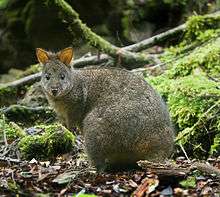Tasmanian pademelon
The Tasmanian pademelon (Thylogale billardierii), also known as the rufous-bellied pademelon or red-bellied pademelon, is the sole species of pademelon found in Tasmania, and was formerly found throughout south-eastern Australia. This pademelon has developed heavier and bushier fur than its northern relatives, who inhabit northern Australia and Papua New Guinea.
| Tasmanian pademelon[1] | |
|---|---|
 | |
| Mt Field National Park | |
| Scientific classification | |
| Kingdom: | Animalia |
| Phylum: | Chordata |
| Class: | Mammalia |
| Infraclass: | Marsupialia |
| Order: | Diprotodontia |
| Family: | Macropodidae |
| Genus: | Thylogale |
| Species: | T. billardierii |
| Binomial name | |
| Thylogale billardierii (Desmarest, 1822) | |
 | |
| Tasmanian pademelon range | |
Males reach around 7 kg (15.4 lbs) in weight, 1–1.2 metres in length including the tail, and are considerably larger than the females, which average 4 kg (8.8 lbs)[3].
Habitat

Pademelons are solitary and nocturnal, spending the daylight hours in thick vegetation. Rainforest, sclerophyll forest, and scrubland[4] are preferred, although wet gullies in dry open eucalyptus forest are also used. Such places, next to open areas where feeding can occur, are especially favoured. After dusk, the animals move onto open areas to feed, but rarely stray more than 100 metres from the forest edge.
The species is abundant and widespread throughout Tasmania.
Diet
The Tasmanian pademelon is a nocturnal herbivore feeding on a wide variety of plants, from herbs, green shoots and grass, to some nectar-bearing flowers.[4]
Once a part of the diet of the thylacine, the Tasmanian pademelon is still preyed upon by other predators of the island, including the Tasmanian devil and quolls. Even so, they are abundant to the point of being culled occasionally (along with other wallabies) to reduce competition for grass with the farmed animals. Hunting of the Tasmanian pademelon is allowed, its pelt having some economic value and its meat being palatable.
Breeding
There is no specific breeding season, though 70% of pademelon births seem to occur around the beginning of winter. Gestation for the female is 30 days. The young are in the pouch for about 6 months thereafter, and are weaned at around 8 months. Joeys are sexually mature at 14–15 months. Pademelons live between 5 and 6 years in the wild.[5]
References
- Groves, C. P. (2005). "Order Diprotodontia". In Wilson, D. E.; Reeder, D. M (eds.). Mammal Species of the World: A Taxonomic and Geographic Reference (3rd ed.). Johns Hopkins University Press. p. 69. ISBN 978-0-8018-8221-0. OCLC 62265494.
- Menkhorst, P. & Denny, M. (2008). "Thylogale billardierii". IUCN Red List of Threatened Species. 2008. Retrieved 29 December 2008.CS1 maint: ref=harv (link)
- Davis, Adrienne. "Thylogale billardierii (Tasmanian pademelon)". Animal Diversity Web. Retrieved 2020-05-14.
- Menkhorst, Peter (2001). A Field Guide to the Mammals of Australia. Oxford University Press. p. 134. ISBN 978-0-19-550870-3.
- AustralianFauna.com Archived 2007-09-25 at the Wayback Machine article on the Tasmanian pademelon
External links

- Park and Wildlife Service Tasmania: Tasmanian Pademelon
